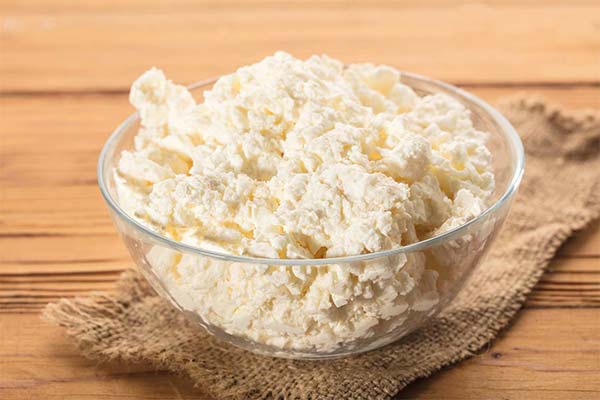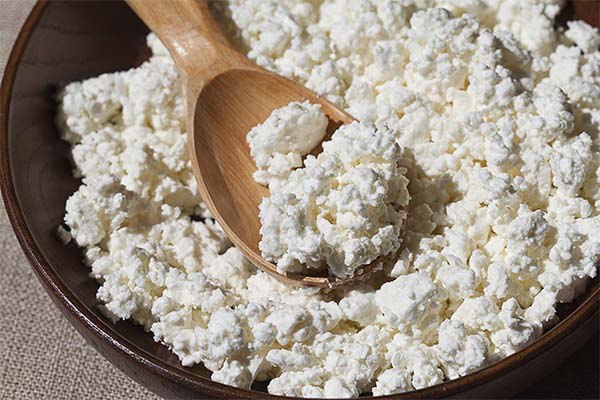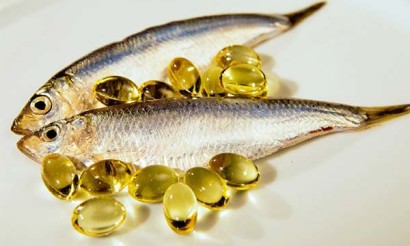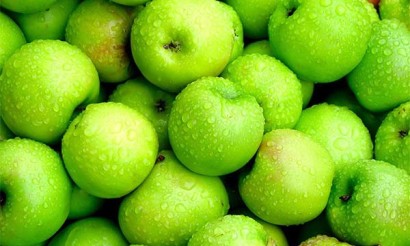Cottage cheese when breastfeeding: the benefits and harms
After the birth of a child, any mother faces the question of the right diet, which will be useful not only for her, but also for the baby. Everyone knows that with milk, the mother sends the child all the necessary substances for its development and the formation of the immune system. So she needs a diet that can restore the lack of substances in her body and not harm the baby's digestion and well-being.
- Is it possible to eat cottage cheese when breastfeeding
- The first month
- The second month
- How to eat curd properly
- How much can I eat per day?
- Can I eat curd at night and on an empty stomach?
- Can I Eat Cheese and Sour Cream
- Is it possible to eat expired cottage cheese?
- The benefits of cottage cheese when breastfeeding
- Is goat curd useful?
- How dangerous is cottage cheese during lactation
- How to add curd to a nursing mother's diet properly
- How to choose a good cottage cheese in the store
- Recipes for cottage cheese dishes for lactation
- Cheese jelly
- Casserole
It is worth noting that even pediatricians today can not answer the question about the use of cottage cheese during breastfeeding unequivocally. One part of the experts insists that the introduction to the diet of dairy products, including cottage cheese, is mandatory. Other doctors advise caution, since there are people who suffer from lactose intolerance, which is likely to manifest itself in the child. Also, experts talk about the appearance of an allergic reaction to dairy products.
Nevertheless, most agree that cottage cheese should be included in the diet of the mother, because it contains useful substances that help the female body recover from pregnancy and childbirth, it contains proteins, which are the main building material. Vitamins, trace elements, amino acids play an important role in the formation of immunity, are responsible for the normal state of bones, teeth, skin, have a beneficial effect on the cardiovascular and nervous systems of the mother and child.
To avoid possible negative consequences, it is necessary to follow the rules of introduction to the diet, monitor the reaction of the body of the mother and baby, choose high-quality cottage cheese in the store, at the market, not to abuse the amount eaten and the addition of all kinds of products that can also cause allergies or a negative response from the gastrointestinal tract.
Is it possible to eat cottage cheese when breastfeeding
Still, most doctors after the birth of the child advise to necessarily include cottage cheese in the diet of the mother. But this process should be gradual. It must be remembered that the absence of contraindications for the use of this product does not guarantee that the body of the newborn will not give a violent reaction to the new food. The baby's digestive system continues to form after birth. The immune system and the principles of immunity also begin to take shape. The baby is just learning to interact with the world around him, and in the first months of life this happens through breast milk. All the substances that enter the mother's body are sure to be passed on to the baby during breastfeeding. Therefore, the introduction of a new product, including cottage cheese, should be done gradually, in small doses, with breaks.

Experts point out that if a woman ate dairy products, including cottage cheese, during pregnancy, the child after birth normally accepts its introduction to the mother's diet during lactation. His body, while still in the womb, forms a habit to the substances contained in the product.
In the first month
It is recommended to eat cottage cheese for mothers immediately after the birth of the child. But it should be a natural product, without additives in the form of sugar, sour cream, dried fruits and other things. The volume of the eaten product is also limited.
You should start with 1-2 tbsp. per day with a break of 1-2 days. It is recommended to eat the product no more than three times a week. It is better to eat the required amount before dinner. There are several reasons for this. First, during the rest of the day you will be able to monitor your child's reaction to the new product. If there are any problems, it is possible to react right away and take appropriate action. In addition, cottage cheese is a product that can cause fermentation in the intestines. Its consumption in the first half of the day allows for better, faster and more effective digestion.
If there is no negative reaction from the baby to a small amount of cottage cheese, you can gradually increase its volume to 100 grams per day. Again, it is worth taking a break of 1-2 days, so as not to burden the liver.
Excluding additional products and flavors is necessary in the first months of life of a child. Not all of them are good for the baby's body, and the mother. Also an allergic reaction, colic or bloating can occur not because of cottage cheese, but because of additional ingredients.
You should not immediately give up cottage cheese completely if your baby has a rash, bloating, diarrhea or other manifestations at the first reception. You can take a break for 1-2 weeks, and then try again later. It is quite possible that by then the digestive system will be a little stronger and will be able to digest the sour milk product.
The second month
If in the first month, the use of mom cottage cheese did not cause a reaction in the baby, you can gradually increase the volume of consumed product. By the end of the second month, it should be 150-200 g on 1-2 days. Again, you should not add additional ingredients. It is better to give preference to a natural product. It is also worth refraining from adding sour cream, and even more so sugar. In the first months, you need to be careful with such products.
It is also worth remembering that in the second month there is still a possibility of allergies, tummy ache, colic, diarrhea. You need to adhere to the norm, not to choose too fatty product, monitor the reaction of the body of the child.
In the second month, you can try again to introduce cottage cheese in the diet of the mother, if the first phase of problems. In this case, the basis for the scheme of the first month. First, the mother eats no more than 2 tbsp. a day, preferably before dinner, and then monitored the reaction of the baby to this product. If the outcome is favorable, the amount eaten is gradually increased to a volume of 150 grams.
If the child continues to perceive the product negatively, then it should be excluded from the diet and find him a replacement that can make up for the necessary substances for normal growth and development of the child.
How to eat cottage cheese correctly
Like any other product, cottage cheese can bring harm to the body if you do not follow the basic rules of its consumption.

How much you can eat per day
A woman breastfeeding should introduce cottage cheese into the diet gradually. In the first days, the amount should not exceed 2 tbsp. per day. Then the volume can be increased to 100-200 g. If the product is low-fat, you can eat a little more.
Also cottage cheese should not be eaten every day. It puts a big load on the liver and kidneys and can lead to weight gain. It is worth to take a break of 1-2 days.
Is it possible to eat at night and on an empty stomach?
Nutritionists and doctors today have sometimes opposite opinions on this issue. One part argues that it is better to eat cottage cheese in the first half of the day, because it takes a long time to be digested by the body. Others insist that curd should not be eaten before 5 pm. On the one hand, cottage cheese helps to satisfy hunger for a long time, so it is suitable for an evening snack three hours before bedtime. On the other hand, it also has a lot of calories, so it can contribute to gaining extra weight. Consumption of cottage cheese for breakfast will help to get all the useful substances, it will allow the body to digest it during the day. But there are studies that indicate that from eating cottage cheese on an empty stomach worse absorption of calcium.
In any case, you need to approach this issue individually, respecting the sense of proportion. It is better to eat cottage cheese as a snack, a second breakfast or an afternoon snack, then it will bring maximum health benefits.
Is it possible to eat cottage cheese with sour cream?
Sour cream is one of the products that complement curd well. But in its use in the period of breastfeeding, you should exercise caution. It is better to give up fatty types of sour cream. This can cause fermentation in the gastrointestinal tract, diarrhea. Not all doctors recommend introducing sour cream into the diet right away, so it is worth paying careful attention to the advice of your pediatrician. It is worth remembering that adding sour cream increases the caloric value of the dish.
Is it possible to eat stale cottage cheese?
It is worth refraining from eating stale product. Acidic milky environment is favorable for the development of a variety of bacteria, including pathogenic, such as E. coli. Consumption of stale cottage cheese can lead to upset stomach and severe food poisoning in the mother and baby.
The benefits of cottage cheese when breastfeeding
This product is almost ideal to get all the necessary substances for vitality. Protein, fat and carbohydrates it contains exactly as much as the body needs. That's why cottage cheese is always in the dietary recommendations that doctors give. Nursing mothers are no exception.

During pregnancy and lactation, a woman gives her baby the basic substances, vitamins, trace elements that the growing and forming body needs. Therefore, the mother may show a lack of them. It is cottage cheese can make up for it. The first thing that suffers is the condition of the skin, nails, hair and teeth. This is due to the fact that with milk from the woman's body leaves the calcium, which is necessary for the baby, so he could form bones and teeth. Cottage cheese helps to make up for this deficiency. Calcium contained in it is absorbed quite well due to the presence of vitamin D in the product, taking an active part in this process.
In addition to calcium, cottage cheese is rich in vitamins A, B, C, E, iron, magnesium, sodium, copper, phosphorus, zinc, fluoride. It contains amino acids: tryptophan, lysine, methionine and the milk protein casein.
Vitamin A is actively involved in the growth process, has a positive effect on vision. B vitamins are good for the nervous system, helping it to resist stress. They are also an important part of the metabolic processes in the body. Vitamin C plays a leading role in the formation of the immune system and the work of the body's defense system. It helps to fight viruses, bacteria, eliminate harmful substances, toxins, free radicals, and takes part in the normalization of blood composition. Vitamin E helps the cardiovascular system function properly, is responsible for the good condition of skin, nails and hair.
Iron provides sufficient oxygenation of the blood. Sodium is responsible for the proper transmission of nerve impulses in the body and the function of all organs. It is involved in the excretion of all harmful substances. Magnesium together with B vitamins has a favorable effect on the nervous system, emotional state, is involved in the heart and blood vessels. Fluorine is necessary for bones, joints, teeth. Zinc is involved in cell renewal.
Amino acids also have beneficial effects, improving sleep, mood, and enhancing immune function. Casein is an important building material and is good at dulling hunger, helping you to feel full for a long time.
Cottage cheese helps maintain the health of not only the mother, but also the child, gives strength for growth and development, helps to satiety. But even a useful product has contraindications, so it is necessary to observe the doctor's recommendations and a sense of proportion.
Is goat curd useful
Goat milk product is usually recommended for those who are allergic to cow's milk and products made from it. Goat's milk curd is better absorbed by the body of the mother and child. The reason is that the casein protein in goat milk product has a similar composition to that contained in the mother's breast milk. But people can be allergic to the casein in cow's milk.
Goat milk also contains a large number of vitamins and trace elements necessary for the normal functioning of the mother and baby. Therefore, this product can be a good substitute for the usual cottage cheese.
But it is worth adhering to the same rules for introducing the product into the diet, as with cow's milk curd, not abusing the volume of its eating. It is worth remembering that not everyone enjoys eating products made from goat's milk. It has a specific taste and smell, so sometimes it takes time to get used to it.
What are the dangers of cottage cheese in lactation
Existing contraindications should not be ignored. They are quite rare, but have an impact on the formation of the diet of not only the mother, but also the baby.

Contraindications that may cause the restriction of cottage cheese consumption or its complete elimination from the diet include:
- Lactose intolerance.
- Problems with assimilation of some components of the product.
- Disorders of the liver and liver ducts.
- Stones in the urinary system.
- The tendency to obesity (in this case, the amount of consumed product or its fat content is limited).
Even if a person has no contraindications to the consumption of cottage cheese, this does not mean that it can be eaten in unlimited quantities in the hope of getting more useful substances.
Casein protein can not only cause an allergic reaction. It retains fluid in the body, including in the joints, which can lead to swelling and joint pain.
Also, the product is obtained by fermentation, so it has bacteria responsible for this process. On the one hand, they are very useful for the digestive system, improving the function of the stomach and intestines. But excessive consumption of the product can provoke the beginning of fermentation in the gastrointestinal tract, causing discomfort, gas, pain, colic, upset stomach, diarrhea or constipation. These consequences can manifest themselves in the body of both the mother and the baby.
Also, exceeding the norm of the product can lead to the formation of fatty tissue and excessive weight in the mother and child. Therefore, it is necessary not only to observe the norm of consumption, but also to pay attention to the fat content of the product. Those women who have a tendency to gain weight quickly, choosing cottage cheese medium or low-fat. It also contains a sufficient number of nutrients.
Excessive consumption of the product has a negative impact on the kidneys. They are engaged in the elimination of protein from the body. Excessive consumption of cottage cheese makes them work harder, which leads to failures in the system. Women in the lactation period should be especially careful. Their body is already weakened by pregnancy and childbirth. Failure to comply with the norm leads not to the recovery of the body, but its overload. Also, an increased content of protein interferes with the normal formation of the urinary system of the baby, forcing it to work harder.
It is also necessary to be careful in choosing a product. An acidic environment is ideal for the reproduction of many types of bacteria, including dangerous ones. If you use stale cottage cheese, you can harm yourself and your baby.
How to introduce cottage cheese into the diet of a nursing mother
Cottage cheese can be part of the diet of the mother from the first days after childbirth. But, in order not to harm not only the baby's body, but also the woman, it is necessary to observe the measure, introducing it into the diet gradually, without abusing the amount and fat content of the product.

It should be borne in mind that not all people like cottage cheese, and breastfeeding mothers are no exception. If before pregnancy a woman did not like cottage cheese, could not bring herself to eat at least a spoonful, then after childbirth, it is likely to remain the same attitude to the product. In this case, do not force yourself to eat it through force. You can find among the dairy products equivalent substitute (cheese, yogurt), which will make up for the lack of essential substances. Also, you should not force-feed a mother who has a casein allergy and intolerance to milk protein. This will not benefit either the woman or her baby. In this case, you should stick to the diet that was recommended before pregnancy and childbirth. More often than not, the baby will react in the same way to dairy products as his mother.
If there is no problem with the use of cottage cheese, in this case you can eat it from the first days after the birth of a baby. But again, you need to be careful to monitor the condition of not only the mother, but also the baby. Therefore, the product is introduced in stages, with breaks and monitoring the reaction of the newborn to the new product.
The first time the mother eats no more than 2 tbsp of natural fresh cottage cheese without additives. It is better to consume it before lunch, so that the digestive system had time to process and assimilate the product. The second half of the day is left to follow the child's reaction. Usually the effects are manifested within 12-24 hours. If it is not followed, you can continue to gradually increase the amount of food you eat.
In the first months of life baby should not exceed 200 grams per day. You should also not eat cottage cheese every day. It is recommended to use it no more than 2-3 times a week.
By the age of six months, the amount of the product consumed by the mother increases to 400 grams. This does not mean that a woman should eat it at one meal. It is better to do it during the day. Also, it does not necessarily have to be the product in its pure form. It can be used to prepare healthy and delicious dishes that can diversify the diet.
Particular attention should be paid to the freshness of the product and its naturalness. Adding sugar, dried fruits, chocolate can cause allergic reactions, and it also increases its caloric value. Stale cottage cheese is dangerous to the occurrence of gastric and intestinal disorders in the mother and child. After opening the packet, the product should be used within 3 days. On the 4-5th day, it is better to make a casserole or cheese cakes. Heat treatment will reduce the number of bacteria.
How to choose good cottage cheese in the store
The choice of the product in the store or on the market should be approached carefully and responsibly. The health of your mother and your baby depends on the quality of the product you buy. The product must be natural, fresh, without added preservatives and other substances that can have a negative impact on health.

If cottage cheese is purchased at the market from private individuals, you should first of all pay attention to the seller and the counter. Untidy person in unkempt clothes and dirty hands are unlikely to sell a safe product. It is unlikely that the production of the product observed basic rules of hygiene. At the market there is an opportunity to try cottage cheese before buying. First, it should be carefully examined. The product should not have an excessive yellow color. This can indicate the presence of dyes or stale. Then it is definitely worth smelling the cottage cheese. The fresh product has almost no pronounced smell, there is only a slight pleasant sour note, it should smell of fresh whey. A stale odor indicates stale or low-quality raw material from which the product was prepared. Then you can taste it. The presence of a pleasant taste with a slight sourness indicates the freshness and quality of the product.
When buying cottage cheese in the store, the buyer has no opportunity to so thoroughly study the product offered. In this case it is necessary to carefully read the information on the package. It is worth giving preference to the products of an already proven manufacturer, in the quality of whose products there is no doubt. Then carefully examine the composition and the indication of the category of goods. It should be indicated on the package that it is cottage cheese, and not a curd-containing product. The composition should not contain anything other than normalized pasteurized milk and sourdough.
It is also important to pay attention to the expiration date. It should not exceed 7 days. A product with a longer shelf life can not be natural. It is still worth buying a product that was packed at the factory just before sale. If the cottage cheese was already packed in the store, it is better to refuse to buy it. Also remember that the product in an open package must be used within three days. But this does not mean that on the 4th or 5th day it should be thrown away immediately. If it did not have a musty smell, it can be used to prepare delicious and healthy dishes.
Recipes for cottage cheese dishes during lactation
It is not necessary in the period of breastfeeding to use cottage cheese only in its pure form. So it can quickly become boring and not cause the mother's appetite. This should be avoided, because the attitude towards the product affects its digestibility by the body. You can prepare delicious and healthy dishes that will help diversify your diet.
Jelly cottage cheese
A tasty and useful substitute for cottage cheese can be cottage cheese jelly. This tasty dessert is well digested by the body.
Ingredients:
- 200 g of fresh cottage cheese, fat content 2-5%;
- 1/2 tbsp. sugar, if you are not allergic, you can replace it with honey;
- 15 g gelatin;
- 1/2 tbsp. milk;
- 125 g sour cream.
Preparation:
- First prepare the gelatin. To do this, pour it into the milk, stir and leave to swell for 20 minutes or follow the recommendations on the package.
- Mix the cottage cheese, sour cream, sugar (honey), a little salt. Mix everything with a blender to make a smooth and fluffy mixture.
- When the gelatin has swollen, heat the milk in a water bath until the gelatin has completely dissolved. Stir the mixture constantly.
- Then cool the milk and gelatin to a temperature of 40 degrees and mix with the curd mass.
- The resulting mixture is spread into molds or glasses, let cool completely at room temperature and place in the refrigerator for 40-60 minutes until solidified.
Casserole

Custard pudding is known to everyone since childhood. This dish is included in the diet in kindergartens, health camps. During the lactation period, you can also treat yourself with this dish. But you should note that the recipe includes a chicken egg. It is an allergen, and it is not immediately included in the diet of mother and child. You can replace chicken eggs with quail eggs or temporarily exclude this ingredient altogether.
Ingredients:
- 500 g of low-fat cottage cheese;
- 2 tbsp. sugar;
- 2 tbsp. sour cream;
- 3 tbsp. semolina;
- 1 egg.
Preparation:
- Preheat oven to 180 degrees.
- Beat the egg and sugar. In a bowl mix all the ingredients. You can add vanilla for flavor or raisins, apples.
- Mix well the resulting mass. Put it into a baking dish greased with oil.
- Bake in an oven for about 40 minutes until golden crust. To make the crust richer, you can grease the casserole with sour cream.
Serve the casserole better warm. After cooling, it becomes less juicy.
In any case, you need to remember a sense of proportion. Dishes made of cottage cheese have a higher caloric value than the product in its pure form.
«Important: All information on this site is provided for informational purposes only. for informational purposes only. Please consult with your health care professional before using any of the recommendations. specialist before using any of the recommendations. Neither the editors nor the authors shall be liable for any possible harm caused by materials."















